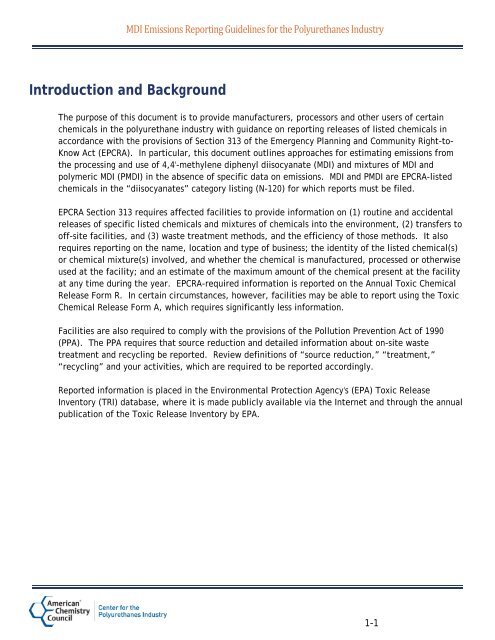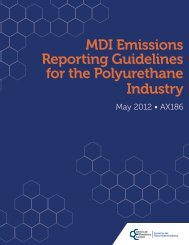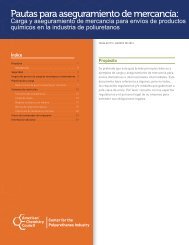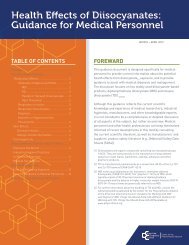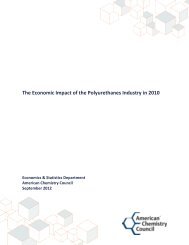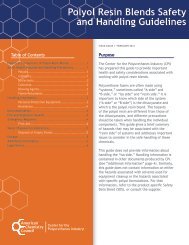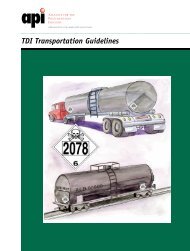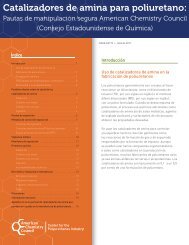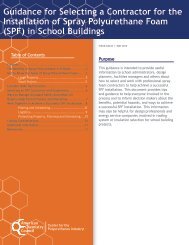MDI Emissions Reporting Guidelines for the ... - Polyurethanes
MDI Emissions Reporting Guidelines for the ... - Polyurethanes
MDI Emissions Reporting Guidelines for the ... - Polyurethanes
You also want an ePaper? Increase the reach of your titles
YUMPU automatically turns print PDFs into web optimized ePapers that Google loves.
<strong>MDI</strong> <strong>Emissions</strong> <strong>Reporting</strong> <strong>Guidelines</strong> <strong>for</strong> <strong>the</strong> <strong>Polyurethanes</strong> Industry<br />
Introduction and Background<br />
The purpose of this document is to provide manufacturers, processors and o<strong>the</strong>r users of certain<br />
chemicals in <strong>the</strong> polyurethane industry with guidance on reporting releases of listed chemicals in<br />
accordance with <strong>the</strong> provisions of Section 313 of <strong>the</strong> Emergency Planning and Community Right-to-<br />
Know Act (EPCRA). In particular, this document outlines approaches <strong>for</strong> estimating emissions from<br />
<strong>the</strong> processing and use of 4,4'-methylene diphenyl diisocyanate (<strong>MDI</strong>) and mixtures of <strong>MDI</strong> and<br />
polymeric <strong>MDI</strong> (P<strong>MDI</strong>) in <strong>the</strong> absence of specific data on emissions. <strong>MDI</strong> and P<strong>MDI</strong> are EPCRA-listed<br />
chemicals in <strong>the</strong> “diisocyanates” category listing (N-120) <strong>for</strong> which reports must be filed.<br />
EPCRA Section 313 requires affected facilities to provide in<strong>for</strong>mation on (1) routine and accidental<br />
releases of specific listed chemicals and mixtures of chemicals into <strong>the</strong> environment, (2) transfers to<br />
off-site facilities, and (3) waste treatment methods, and <strong>the</strong> efficiency of those methods. It also<br />
requires reporting on <strong>the</strong> name, location and type of business; <strong>the</strong> identity of <strong>the</strong> listed chemical(s)<br />
or chemical mixture(s) involved, and whe<strong>the</strong>r <strong>the</strong> chemical is manufactured, processed or o<strong>the</strong>rwise<br />
used at <strong>the</strong> facility; and an estimate of <strong>the</strong> maximum amount of <strong>the</strong> chemical present at <strong>the</strong> facility<br />
at any time during <strong>the</strong> year. EPCRA-required in<strong>for</strong>mation is reported on <strong>the</strong> Annual Toxic Chemical<br />
Release Form R. In certain circumstances, however, facilities may be able to report using <strong>the</strong> Toxic<br />
Chemical Release Form A, which requires significantly less in<strong>for</strong>mation.<br />
Facilities are also required to comply with <strong>the</strong> provisions of <strong>the</strong> Pollution Prevention Act of 1990<br />
(PPA). The PPA requires that source reduction and detailed in<strong>for</strong>mation about on-site waste<br />
treatment and recycling be reported. Review definitions of “source reduction,” “treatment,”<br />
“recycling” and your activities, which are required to be reported accordingly.<br />
Reported in<strong>for</strong>mation is placed in <strong>the</strong> Environmental Protection Agency's (EPA) Toxic Release<br />
Inventory (TRI) database, where it is made publicly available via <strong>the</strong> Internet and through <strong>the</strong> annual<br />
publication of <strong>the</strong> Toxic Release Inventory by EPA.<br />
1-1


